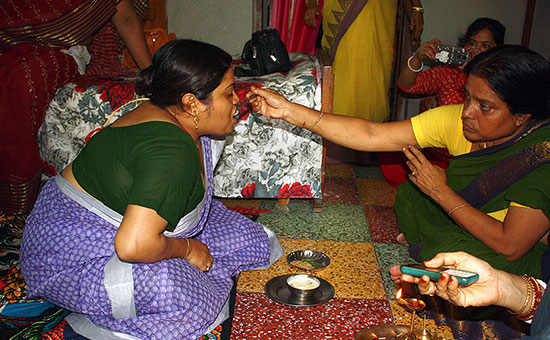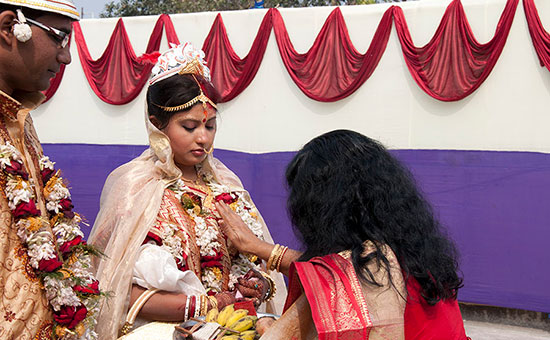A typical quintessential Bengali wedding is rich in rituals
and heritage. Wedding vows are taken by the bride and groom but it is actually an
amalgamation of two families. The rituals performed during the ceremony clearly
unite both the bride & groom and their families. The rituals involve participation
by the oldest and youngest family members making it a beautiful, colourful,
joyous moment for one and all.
Aiburo Bhat marks
the start of the ceremony. The bride and the groom celebrate the happy ending
of their bachelorhood in their own household separately. Usually the mother
prepares the meal for her daughter/son. Personal favourites are served, but the
must have item is ‘payesh’. It is
usually organised a day before the big day. (Payesh
is a sweet dish made of milk rice and sugar or jaggery. It is a form of kheer.)
The wedding day commemorates with Dadhimangal,
a ritual where the bride and the groom are fed before sun rises. Generally they
get up at 3 to 3.30 am to start the ritual. According to the ritual both of
them fast during the day (cannot take any food after Dadhi Mangal). Curd,
sweets, chidwa (flattened rice) is usually fed. Food items vary according to
local culture and heritage.
 Dadhimangal
Dadhimangal
After this ceremony usually seven or nine married women (in
odd numbers) visits Ma Ganga and she is invited for the wedding. Most
conventionally ‘Mami’ (wife of maternal uncle) stay in this group and she leads
the team. This is known as Ganga Nimantran.
![]()
 Ganga Nimantran
Ganga Nimantran
Next comes Holud Kota. The groom is first smeared with turmeric paste mixed with Mustard Oil. A little is kept for thebride. The groom's family sends this holud to the brides place with a lot of gifts and sweets. Dahi,
Mustart oil, a Big Fish (generally just taken out from pond) is a must thing in
that particular Tattwo. This is popularly known as Tattwo. Decorating twattoo has become very popular in weddings.
 Holud Khela
Holud Khela
The gifts given to the bride come in different trays. The turmeric paste that comes from the groom's place is now smeared on the bride.
Along with this Briddhi Sraddha is
performed. By this ritual the forefathers are invited to be a part of the
ceremony and they offer homage to their forefathers. As stated earlier marriage
for Bengalis is actually a communion of two families.
In the evening the groom comes to the bride’s place usually
in a car decorated with flowers. The mother of the bride along with four or six
other married women receive the groom. The ritual is called Jamai boron.
The groom is
taken to chadnatala (place where the marriage function is organized) where an
initial puja is performed along with the person who will do the Konyo daan.
After he changes into his Jor, the bride is seated in a wooden platform known as
piri and carried by some male members
of her family / brothers to the mandap. Whilst being carried the bride covers her
face with betel leaves. The bride circumambulates around the groom seven times
helped by the mail relatives carrying her. This is called Saat Paak.
.jpg) Saat Paak
Saat Paak
Next
the bride removes the betel leaves – when the four eyes of the bride and groom
meet it is known as Subho Dristi.
The garlands are being exchanged as Mala
Bodol. After that the bride's father usually gives his daughter’s hand to son-in-law by a ritual called Konya Daan.
After this Hom ceremony takes
place. Here the bride and groom sit next to each other in front of the fire
whilst the priest chants Vedic mantras which repeat when asked to and make
offerings to the fire.
Saptapadi is when the
couple go around the fire seven times whilst taking vows. A knot is tied called
Gatchora (A virtual bond that never lets them to be separate) and then the couple does the saptapadi.
After the
Konyadan the ceremony continues in the brides place. The same night usually
friends and brothers and sisters of the newly wed celebrate by playing
different games like antakshari. It is called BASHOR. That
is a big event and most waited time for everyone in the house especially
younger people. Now days that essence of Basor has fainted due to shortage of
time and lack attraction of younger people. Usually called bashi biye as we
shall read in the next para.
After the marriage ceremony gets over the next day a
ceremony called Bashi Biye is organized.
The main attraction of the ceremony is Sindoor Daan. Here the groom smears vermillion (sindoor) on the bride's head. The bride then becomes wife.
Note that
the bride leaves her father’s place on the second day after marriage unlike say
Punjabi weddings where the bride leaves the same night since wedding ceremony
gets over in one day.
Amidst all the rituals, fun, frolic comes the saddest ritual
is Konya Bidai. The bride leaves the father's abode to enter her new family. Before leaving she throws paddy seeds (chawal) and aloo to mother’s Aanchal (end of
a sari). This is a symbolic ritual to tell parents I am leaving after repaying
all debts. Kankanjali marks the end
of her stay in her father’s home.
The bride and the groom enter their new life. The bride goes to the groom's family where again a Bodhu Boron is
done. (Bodhu boron is a ritual done
after the newly wedded daughter in law enters her in laws home. It is a welcome
gesture for the bride by in her in laws.) This
time the groom’s mother receives her Chele
and Cheler bou – groom and the bride.
The bride enters her new home.
 Bodhu boron
Bodhu boron
A lot of rituals take place. But these vary according to
local cultures. For example if the grooms family is ‘ghoti’ (that is of West Bengal origin) the bride enters her in-laws
in the morning but if the groom is ‘bangal’
(that is of East Bengal origin) the bride enters her new house after sundown.
Note that the night the bride comes into her husband’s
house, the couple are put up in separate rooms according to tradition.
The celebrations comes to an end the next
day. In the morning the newly wedded bride serves the family ghee-bhaat popularly known as Bou Bhat. The serving of ghee bhat generally
starts with eldest member of the family.
The ceremony comes to an end with Full Sojjya where the bed of the newly married couple is decorated with
flowers to mark the beginning of a happy married life.
Bengalis
do not have a tradition of mangalsutra but the mother in law usually gifts the
bride with a LOHA BADHANO, a bangle
made of iron plastered with gold.
To read all articles on marriage ceremony rituals
Editor – This article is written by a friend who prefers to remain
anonymous. Given my name as author so that there is an email id for feedback.
Pictures by Diptangshu Sengupta